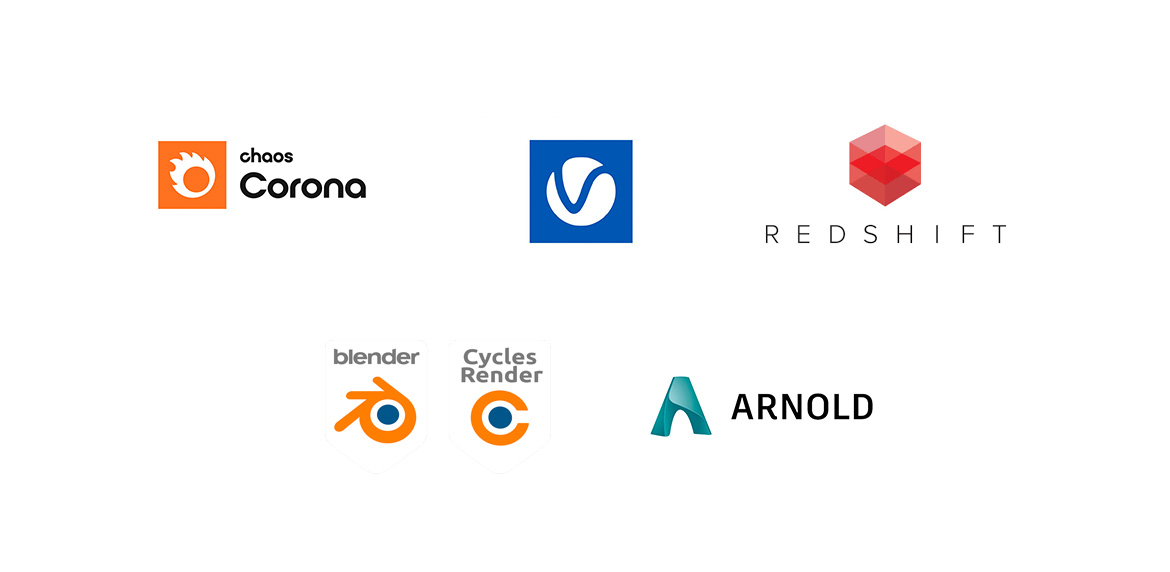In the graphic design, animation, and architecture industries, the rendering process plays a crucial role in visualizing and presenting ideas and projects.
Choosing the right rendering engine is essential to achieving visually impactful and efficient results.
This article explores five of the most influential rendering engines: VRay, Corona, Cycles, Arnold, and Redshift, highlighting their features, advantages, and specific applications.



VRay: The All-Terrain Rendering Engine
VRay is widely recognized for its versatility and photorealistic quality across various fields such as film, animation, and architectural visualization. With its advanced capability to handle complex lighting and material simulations, VRay is the preferred choice for artists and designers seeking reliability and detailed control in their rendering projects.
Corona Renderer: Efficiency and Realism
Corona Renderer has gained popularity for its impressive balance between quality and ease of use. While it is especially popular in architectural visualization, its application has extended to advertising and interior design. Corona excels in efficiently handling light and materials, allowing users to create stunning scenes with less technical effort.
Cycles: Blender's Open Source Rendering Engine
Cycles is Blender's integrated rendering engine, known for its flexibility and power in an open-source framework. It is highly appreciated in the animation and 3D modeling community for its seamless integration with Blender and its ability to produce high-quality results through a node-based approach that facilitates complex and detailed experimentation.
Arnold: The Choice of Film Professionals
Arnold is a rendering engine that has made a name for itself in the film industry thanks to its impressive scalability in large-scale productions. Used by studios such as Sony Pictures Imageworks and Industrial Light & Magic, Arnold is known for its efficiency in managing complex and dense scenes, making it ideal for visual effects and character animation.
Redshift: GPU-Accelerated Rendering
Redshift stands out for its focus on GPU-accelerated rendering, allowing significantly faster rendering times. This makes it a preferred choice for projects requiring rapid iteration and real-time visualizations, such as video games and VR simulations. With support for multiple platforms and 3D tools, Redshift is versatile and powerful.
Conclusion
Choosing the right rendering engine depends on the specific needs of the project, budget, and available technical expertise. While VRay and Arnold offer robust and proven solutions for large productions, Corona, Cycles, and Redshift provide flexible alternatives that can suit projects of different scales and technical requirements. Exploring each of these engines can provide designers and animators with the tools necessary to transform their creative visions into impactful and compelling images.
Differences between Traditional Rendering Engines and Augmented Reality
Traditional rendering in engines like VRay, Arnold, and Redshift focuses on creating images or animation sequences that are pre-processed and viewed as final products. These engines are designed to produce maximum realism and visual detail, often at the cost of longer processing times and intensive computational resource usage.
On the other hand, rendering for augmented reality (AR) differs significantly in several key aspects. AR requires real-time rendering, as images must adjust and respond immediately to changes in the environment and user interactions. This involves a focus on optimization and efficiency, often sacrificing maximum visual quality to maintain smooth and responsive performance.
AR engines use techniques such as location-based rendering and dynamic occlusion to convincingly integrate virtual objects into the user's real environment.
This need to balance quality and real-time performance in AR contrasts with the ability of traditional rendering engines to use computationally intensive techniques to create extremely detailed and realistic images. Both technologies have their place in the digital visualization spectrum, each offering unique solutions for different needs and applications. While traditional engines are ideal for detailed pre-visualizations and final renders in fields such as architecture and film, AR opens up new possibilities for real-time interactions and immersive experiences in real-world environments.
Latest News All Articles

Unreal Engine 5: The Superior Choice for Architectural Visualization
We explore why Unreal Engine 5 (UE5) is becoming ...

Exploring Spaces with 3D Web Virtual Tours: The Best Tools..
3D web virtual tours have opened a window to the world...

The Competitive Advantage of Virtual Reality
The real estate industry is in the midst of a digital transformation...
